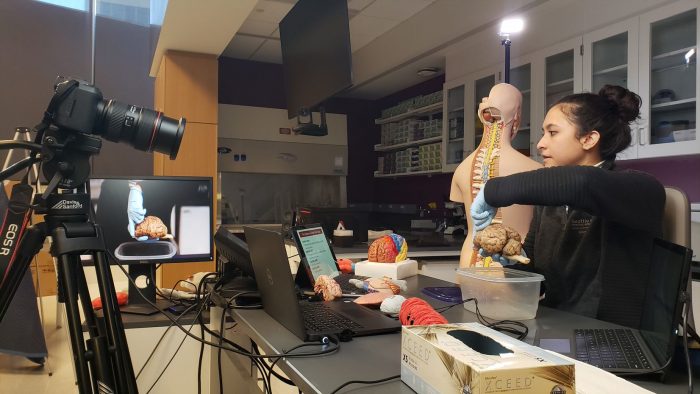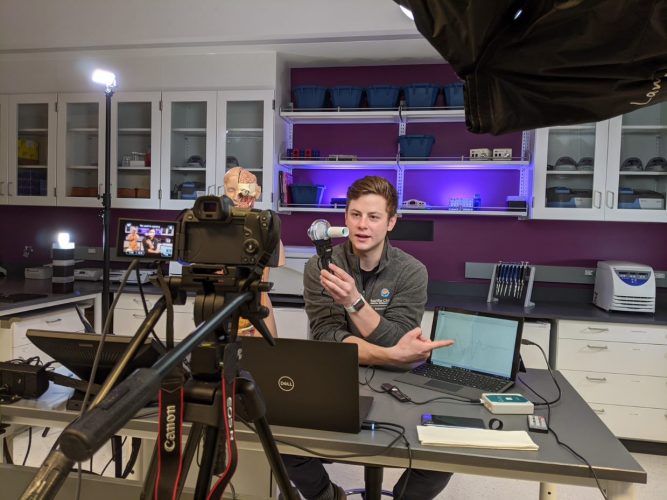When the COVID-19 pandemic first led to a pivot to online instruction in the spring of 2020, the Science Education Department at Seattle Children’s Research Institute was forced to hit pause on in-person programming.
However, thanks to an investment in high-quality equipment and the creativity and adaptability of the Science Education team, the programs have been able to thrive in a virtual format.
Transition to virtual
To pivot to a virtual format, the team purchased a video camera and lighting equipment to make the lessons feel professional, says Dr. Amanda Jones, senior director of education initiatives at Seattle Children’s Research Institute.
Virtual lessons were first offered for the Virtual Research Training Program for 11th and 12th grade students last summer. Virtual Science Adventure Lab lessons for elementary students were added in January. In total, the team has taught virtual lessons to over 100 distinct classes, reaching more than 2,200 students spanning from kindergarten through sixth grade. Prior to the pandemic, the Science Adventure Lab program traveled to schools around the region in person in a 45-foot mobile science lab, while the Research Training Program hosted students in the Science Discovery Lab at the research institute’s Building Cure.
All of the Science Education Department courses focus on underserved students.
 “It’s not the same as holding a brain, or touching the lungs or anything like that, but we wanted to make it as immersive as possible,” said Sarah Garcia, a senior mobile laboratory scientist with the research institute’s Science Education Department, of the Virtual Science Adventure Lab lessons. “Having a nicer camera and being able to zoom in on all of those little details, I think really added to the lessons and to their experience.”
“It’s not the same as holding a brain, or touching the lungs or anything like that, but we wanted to make it as immersive as possible,” said Sarah Garcia, a senior mobile laboratory scientist with the research institute’s Science Education Department, of the Virtual Science Adventure Lab lessons. “Having a nicer camera and being able to zoom in on all of those little details, I think really added to the lessons and to their experience.”
The team shifted from teaching lab lessons in person to livestreaming science lessons from its Science Discovery Lab. They have condensed 60-minute lessons taught on the Science Adventure Lab to 20 minutes for virtual lessons. Some of the lessons offered include neuroscience, DNA isolation, vital signs and a lungs demonstration.
“I’m glad that we are able to continue to provide the resource, if in a slightly modified way,” said Jones of the department’s transition to virtual lessons. “It’s still engaging and important and helps keep kids interested in science.”
Benefits of the virtual format
Even though Jones says there is no substitute for an in-person experience there have been some benefits from the current virtual approach over in-person lessons.
“We’ve been able to broadly expand. We’re still serving underserved students, but we’ve been able to expand the total number that can participate and where they can participate from,” she said.
After one school counselor in Philadelphia shared a post on TikTok that mentioned the research institute’s Research Training Program, Jones says the program will now have over 400 students participating this summer.
In total, students from 11 different countries, including Peru and the United Arab Emirates, are registered to attend, Jones says.
“That’s all word of mouth through TikTok,” said Jones. “Of course we’re disappointed we can’t see students in person, but the silver lining has been that this has allowed us to increase our capacity and geographic reach.”
Corey Coombs, a senior mobile laboratory scientist with the research institute’s Science Education Department, said another benefit to teaching Virtual Science Adventure Lab classes has been seeing how family members become drawn into the lessons.
 “When we turned virtual, we weren’t 100% sure what to expect,” he said. “But one thing that we saw immediately, within our first lesson, was when the students had their cameras on, we would see a sibling creep in and watch. And we’d see a parent in the background watching. All of a sudden, they’d have four or five people in the background watching. So it wasn’t just the student, it was their surroundings that were also taking in the lessons.”
“When we turned virtual, we weren’t 100% sure what to expect,” he said. “But one thing that we saw immediately, within our first lesson, was when the students had their cameras on, we would see a sibling creep in and watch. And we’d see a parent in the background watching. All of a sudden, they’d have four or five people in the background watching. So it wasn’t just the student, it was their surroundings that were also taking in the lessons.”
Garcia also said that in a year where many students have spent the majority of their time with the same teacher, they welcomed a break from their teachers.
“A lot of the feedback that we received from the teachers has been basically saying, ‘This is just a great way to not only introduce a topic in science, but also to definitely have a break from my face,’” she said.
While the transition to virtual learning has been an adjustment for students, Coombs also said that the transition to virtual lessons was a new experience for his team as well, noting that they taught and trained each other on how to use their new equipment.
Looking ahead
Because the virtual format has allowed the team to expand its reach, Jones says the department plans to offer some lessons virtually even once the pandemic is over.
“Our summer Research Training Program this year is virtual and we plan to keep part of that going so that we can reach more students, because definitely it was one of the biggest benefits,” she said. “Being able to see a student or a class in Eastern Washington, Seattle and somewhere else all in one day – that was something that we couldn’t do before that now we can do with a virtual format.”

